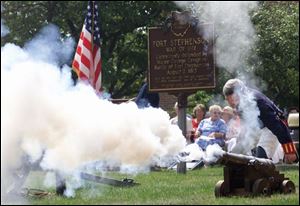
Fremont remembers 1813 battle
8/3/2001
Pvt. Bob Gillmor pulls a cord to set off his homemade three-pound cannon during the Fremont festivities.
FREMONT - The War of 1812's Battle of Fort Stephenson doesn't get the attention of famous U.S. military stands like the Alamo and Guadalcanal, but it should, according to Gerry Altoff.
Standing on the battle site yesterday outside the Birchard Public Library, the military historian said Fremont's annual Croghan Day event commemorates a turning point in the war against the British.
On Aug. 2, 1813, a hastily assembled force of 160 American soldiers led by Maj. George Croghan defeated 1,500 British troops converging on the fort.
The successful defense of Fort Stephenson is an example of courage and sacrifice by ordinary soldiers defending their country, Mr. Altoff said.
“I feel this is an extremely important celebration,” he told a crowd of about 70 people. “In some respects, it is Fremont's Memorial Day. The soldiers who fought here represent all of the men and women who have served this country.”
Standing at a podium in the hazy, late-morning heat, Mr. Altoff wore the khaki shirt, olive slacks, and wide-brimmed hat of a park ranger.
Sitting on chairs on the library's lawn, some of his listeners fanned themselves with their event programs.
Mr. Altoff urged those in the crowd to place themselves in the position of the soldiers in the fort 188 years ago.
“On this day at this time on this very location stood about 160 soldiers - hot, tired, lonely, and scared,” he said. “The morning of Aug. 2, 1813, the men of Fort Stephenson felt anything but heroic.”
The defenders of Fort Stephenson, an American supply base, were pulled together on short notice from other U.S. units, Mr. Altoff said. With the British and their Indian allies approaching the fort, Gen. William Henry Harrison ordered Major Croghan, then 21, to destroy and abandon the base.
Major Croghan either ignored or never got the general's message. Instead, when two columns of British troops poured into a ditch outside the fort, the Americans fired on them with their only cannon.
“That first double charge of cannon unleashed an unspeakable carnage in that ditch,” Mr. Altoff told the hushed crowd. After one more blast, the British fled, leaving nearly 100 casualties.
The 6-inch cannon that turned the battle, “Old Betsy,” rests on the library's lawn, near Major Croghan's grave and a tall stone column marking the battle. After Mr. Altoff spoke, a wreath was laid at the grave in honor of those who fought at the fort.
As bugler Dana Dorsey played the last notes of “Taps,” Old Fort historian Bob Gillmor - wearing the blue wool coat and knee-high boots of an 1813 American solider - fired a half-sized replica of the historic cannon. A thunderous boom shook the hilltop site as white smoke drifted over Croghan Street below.
The defense of Fort Stephenson, along with the U.S. victory that year in the Battle of Lake Erie, stymied British efforts to conquer the region, Mr. Altoff said.
“From this point, British efforts ebbed east and north,” he said. “The British and Indians never threatened Ohio again. ... The importance of the Battle of Fort Stephenson cannot be overestimated.”
The victorious American troops quickly dispersed, heading back to their home units in Pennsylvania, Kentucky, Virginia, and Tennessee. That is one of the factors that has made identifying the soldiers who fought in the battle so difficult, Mr. Altoff said.
Historians have identified about half of the U.S. troops involved in the battle. Even the lone American killed during the fighting is anonymous. “They were not elite soldiers,” he said. “They were not the cream of the crop. They were not the bravest of the brave. They were just ordinary soldiers.”